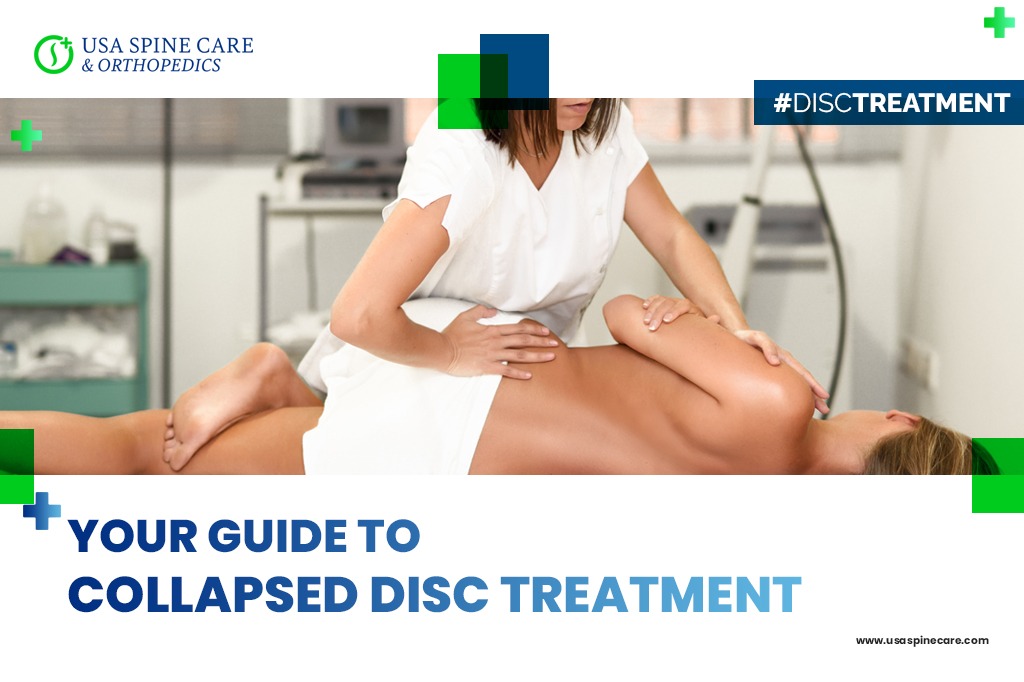- Conditions
- Procedures
- Patient care
- Why choose us
- Our Doctors
- Contact
Your Guide to Collapsed Disc Treatment

A collapsed disc is a condition affecting the spinal discs that is largely connected to degenerative disc disease. This generally describes age-related changes that occur to the rubbery spinal discs that help cushion the vertebrae and allow for movement. Over time, these discs essentially lose water content and elasticity.
This makes them less flexible and more brittle, leading to a wide range of problems, including bulging discs, herniated discs and collapsed discs. Despite the name, a collapsed disc does not spontaneously collapse like a building. Instead, this condition refers to the gradual loss of disc height over time.
While loss of disc height is not painful by itself, a severe collapsed disc causes compression between the vertebrae. The increased friction can cause the development of bone spurs, which combined with the loss of disc height, can increase the likelihood of nerve compression.
Whether you have been diagnosed with a collapsed disc or are researching potential causes of pain, the following guide can help. By learning more about treatment options, you can take a more proactive approach to neck pain, back pain or whatever symptoms are affecting your quality of life. Chronic pain caused by a collapsed disc does not always mean surgery, although it can be the best option in some cases.
If you have any questions as you read this informative overview, don’t hesitate to reach out. The USA Spine Care Team is here to help.
Commit to basic conservative treatment and a healthy lifestyle
If a collapsed disc is diagnosed by a physician as the underlying cause of acute pain or chronic pain, the first step is usually a course of conservative therapy. The goal is to manage symptoms and improve function. Commonly recommended treatments include:
- Periods of rest to reduce stress on the spine
- Over-the-counter medication, such as nonsteroidal anti-inflammatory drugs (NSAIDs)
- Alternating hot and cold therapy, such as a heating pad and an ice pack
- Gentle stretches
While the underlying causes of collapsed discs are non-reversible, it is still important to commit to a spine healthy lifestyle. There are several key ways to reduce the overall pressure on the discs, which can both help to relieve neck or back pain and potentially slow down the disc degeneration process. Lifestyle adjustments that can help a collapsed disc include:
- Correcting posture
- Managing weight
- Improving mechanics
- Eating a nutrient-rich diet
- Getting regular exercise to improve blood flow and strengthen supporting muscles
The importance of physical therapy and other interventions for chronic pain
If symptoms don’t improve with basic treatments, more advanced conservative therapy may be the next step. Physical therapy can be an important method to help treat collapsed disc symptoms and improve spine function. A therapist can work with you to develop a personalized treatment plan consisting of therapeutic exercise, hands-on manual therapy and other interventions.
Another common intervention for chronic pain related to a collapsed disc, bulging disc or herniated disc is a therapeutic injection. A guided corticosteroid injection, often into the epidural space of the spine can help to relieve inflammation and pain for a period of weeks or longer.
When to consider surgical approaches to collapsed disc treatment
Surgery for a collapsed disc is usually seriously considered if conservative treatments have been fully exhausted and chronic pain and other symptoms are negatively affecting quality of life and activity level.
Approaches to collapsed disc surgery vary depending on the severity of the loss of disc height and extent of nerve compression. Decompression procedures can remove displaced spine material that is putting pressure on nerves. Stabilization procedures, also known as fusion, may be required if full disc removal is needed.
With advances in microsurgical technology and the continued development of technique and treatment protocols, many procedures for the treatment of collapsed discs can be performed on an outpatient basis. Always discuss the possibility of minimally invasive spine surgery with a treating physician or prospective surgeon.
Learn more from the experts at USA Spine Care today
To learn more about our comprehensive approach to collapsed disc treatment, contact USA Spine Care today. Our minimally invasive spine surgery is performed on an outpatient basis, leading to a reduced complication risk and a more streamlined recovery compared to traditional hospital-based neck or back surgery. No matter where you are in your treatment journey, our multidisciplinary team can help you develop a customized treatment plan that fits your needs and lifestyle.
Collapsed Disc Quick Answers:
Can a collapsed disc heal?
A collapsed disc is generally related to age-related changes in the body that causes the discs to dry out and lose height. These changes are non-reversible, meaning that a collapsed disc does not heal. However, through conservative treatment it is possible to manage symptoms of a collapsed disc.
What causes a collapsed disc?
A collapsed disc occurs in conjunction with a condition called degenerative disc disease. Over time, the natural aging process causes the spinal discs to lose water content and elasticity. One of the effects of these changes is a loss in disc height, which in severe cases is diagnosed as a collapsed disc.
What happens if a disc collapses?
Loss of disc height decreases the space between the vertebrae in the spine. This compression, along with increased friction, can cause nerve compression and the development of bone spurs. Symptoms include neck pain and back pain, along with radiating symptoms such as tingling, numbness and muscle weakness.
How long does it take for collapsed disc symptoms to improve?
If a collapsed disc is causing symptoms, conservative treatment can often improve pain and mobility problems in a span of weeks or months. Surgery may become an option after that if chronic pain develops. Recovery times vary depending on the type of surgery, with outpatient minimally invasive procedures offering the possibility of a quicker recovery period.
